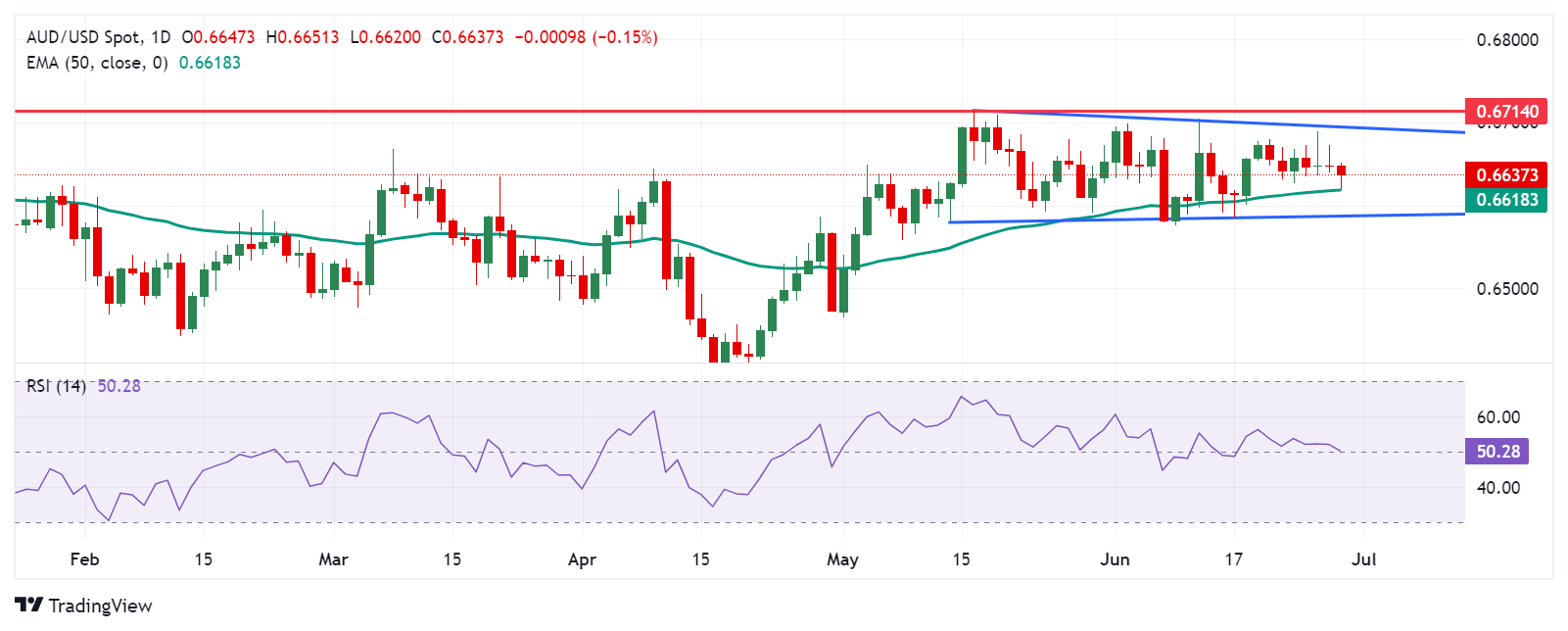- Australian dollar loses ground as RBA Deputy Governor Hauser advises against making policy based on a single inflation report.
- High inflation in Australia has fueled speculation that the RBA could raise interest rates again in August.
- The US dollar appreciates on higher yields ahead of the release of core PCE on Friday.
The Australian Dollar (AUD) is depreciating against the US Dollar (USD) on Friday, which could be attributed to dovish comments from Reserve Bank of Australia (RBA) Deputy Governor Andrew Hauser. Hauser said it would be a “serious mistake” to make policy in response to a single inflation report. He stressed that there is still a set of economic data to come that will require detailed analysis, according to Bloomberg.
The AUD gained ground following the release of May’s monthly Consumer Price Index (CPI), which was higher than expected. Persistently high inflation has fueled speculation that the RBA could raise interest rates again in August.
The US Dollar (USD) gains ground on higher US Treasury yields. Friday’s underlying Personal Consumption Expenditure (PCE) Price Index is projected to decline year-on-year to 2.6% from the 2.8% previous. This data is considered the preferred inflation indicator of the Federal Reserve (Fed).
Daily Market Drivers Summary: Australian Dollar Falls on Fed’s Dovish Comments
- The 10-year Australian government bond yield soared above 4.4%, hitting a three-week high, as a high inflation reading fueled fears the Reserve Bank of Australia could hike interest rates again at the next meeting in August.
- Michelle Bowman, a member of the Board of Governors of the Federal Reserve (Fed), signaled Thursday that she is not yet ready to support a central bank rate cut with inflation pressures still high. Bowman said, adding “We are not yet at the point where it is appropriate to lower the policy rate, and I continue to see a number of upside risks to inflation,” according to Reuters.
- Annualized U.S. gross domestic product (GDP) expanded 1.4% in the first quarter, slightly above the previous reading of 1.3% but still marking the slowest growth since contractions in the first half of 2022.
- U.S. Initial Jobless Claims on Thursday showed the number of people filing for unemployment benefits fell to 233,000 in the week ending June 21, below market expectations of 236,000. The claim count fell for the second straight week since hitting a 10-month high of 243,000 in early June.
- The first US presidential debate between President Joe Biden and Republican presidential candidate Donald Trump began on CNN News. Biden acknowledged that “inflation had raised prices substantially higher than at the beginning of his term, but he said he deserves credit for ‘rebuilding things’ after the coronavirus pandemic.” In response, Trump condemned high levels of inflation. He suggested tariffs would reduce deficits and urged looking at countries like China, according to Reuters.
- Christopher Kent, deputy governor of the Reserve Bank of Australia (RBA), said on Wednesday that recent data underscores the need to remain vigilant against possible increases in inflation. Kent noted that current policies are contributing to slower demand growth and lower inflation. He also mentioned that options for future interest rate adjustments are not excluded, according to Bloomberg.
- Australia’s monthly Consumer Price Index (CPI) rose 4.0% in the year to May, up from a 3.6% rise in April, according to data released on Wednesday by the Australian Bureau of Statistics (ABS). ). This increase exceeded the market forecast, which predicted a growth of 3.8% for the reporting period.
Technical Analysis: Australian Dollar falls below 0.6650
The Australian Dollar is trading around 0.6630 on Friday. The daily chart analysis indicates a neutral bias for the AUD/USD pair as it consolidates within a rectangle formation. The 14-day Relative Strength Index (RSI) is at the 50 level, which also suggests neutral momentum. Further movement could signal a clear directional trend.
The AUD/USD pair finds support around the 50-day Exponential Moving Average (EMA) at 0.6618. A break below this level could lead the pair to test the lower boundary of the rectangular formation near 0.6585.
On the upside, the AUD/USD pair could face resistance near the upper boundary of the rectangle formation around 0.6695, close to the psychological level of 0.6700. Additional resistance appears at 0.6714, the highest level since January.
AUD/USD: Daily Chart
Australian Dollar PRICE Today
The table below shows the percentage change of the Australian Dollar (AUD) against major currencies today. Australian dollar was the weakest currency against the US dollar.
| USD | EUR | GBP | JPY | CAD | AUD | NZD | CHF | |
|---|---|---|---|---|---|---|---|---|
| USD | 0.10% | 0.03% | 0.10% | 0.12% | 0.21% | 0.20% | 0.08% | |
| EUR | -0.10% | -0.06% | -0.03% | 0.02% | 0.09% | 0.10% | -0.02% | |
| GBP | -0.03% | 0.06% | 0.02% | 0.07% | 0.16% | 0.15% | 0.01% | |
| JPY | -0.10% | 0.03% | -0.02% | 0.02% | 0.12% | 0.10% | -0.01% | |
| CAD | -0.12% | -0.02% | -0.07% | -0.02% | 0.08% | 0.07% | -0.07% | |
| AUD | -0.21% | -0.09% | -0.16% | -0.12% | -0.08% | -0.01% | -0.14% | |
| NZD | -0.20% | -0.10% | -0.15% | -0.10% | -0.07% | 0.00% | -0.14% | |
| CHF | -0.08% | 0.02% | -0.01% | 0.00% | 0.07% | 0.14% | 0.14% |
The heat map shows percentage changes for major currencies. The base currency is selected from the left column, while the quote currency is selected from the top row. For example, if you choose the Australian Dollar from the left column and move along the horizontal line to the US Dollar, the percentage change shown in the box will represent the AUD (base)/USD (quote).
Australian Dollar FAQs
One of the most important factors for the Australian Dollar (AUD) is the level of interest rates set by the Reserve Bank of Australia (RBA). Since Australia is a resource-rich country, another key factor is the price of its largest export, iron ore. The health of the Chinese economy, its largest trading partner, is a factor, as is inflation in Australia, its growth rate and the Trade Balance. Market sentiment, i.e. whether investors are betting on riskier assets (risk-on) or seeking safe havens (risk-off), is also a factor, with risk-on being positive for the AUD.
The Reserve Bank of Australia (RBA) influences the Australian Dollar (AUD) by setting the level of interest rates that Australian banks can lend to each other. This influences the level of interest rates in the economy as a whole. The RBA’s main objective is to maintain a stable inflation rate of 2%-3% by adjusting interest rates up or down. Relatively high interest rates compared to other major central banks support the AUD, and the opposite for relatively low ones. The RBA can also use quantitative easing and tightening to influence credit conditions, with the former being negative for the AUD and the latter being positive for the AUD.
China is Australia’s largest trading partner, so the health of the Chinese economy greatly influences the value of the Australian Dollar (AUD). When the Chinese economy is doing well, it buys more raw materials, goods and services from Australia, which increases demand for the AUD and drives up its value. The opposite occurs when the Chinese economy is not growing as fast as expected. Therefore, positive or negative surprises in Chinese growth data often have a direct impact on the Australian Dollar.
Iron ore is Australia’s largest export, with $118 billion a year according to 2021 data, with China being its main destination. The iron ore price, therefore, may be a driver of the Australian dollar. Typically, if the price of iron ore rises, the AUD also rises as aggregate demand for the currency increases. The opposite occurs when the price of iron ore falls. Higher iron ore prices also tend to result in a higher likelihood of a positive trade balance for Australia, which is also positive for the AUD.
The trade balance, which is the difference between what a country earns from its exports and what it pays for its imports, is another factor that can influence the value of the Australian dollar. If Australia produces highly sought-after exports, its currency will gain value solely from the excess demand created by foreign buyers wanting to purchase its exports versus what it spends on purchasing imports. Therefore, a positive net trade balance strengthens the AUD, with the opposite effect if the trade balance is negative.
Source: Fx Street
I am Joshua Winder, a senior-level journalist and editor at World Stock Market. I specialize in covering news related to the stock market and economic trends. With more than 8 years of experience in this field, I have become an expert in financial reporting.








